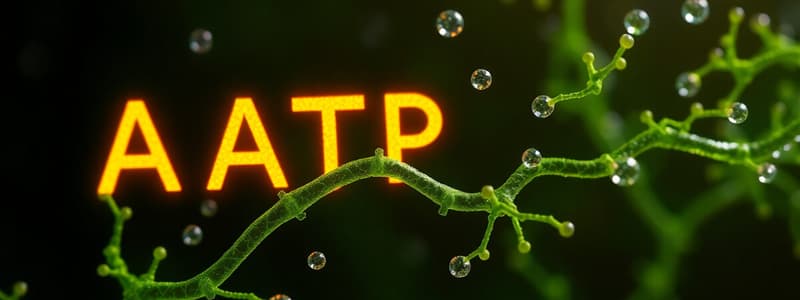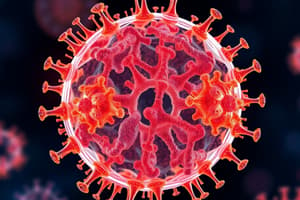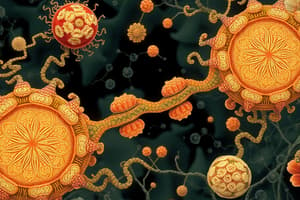Podcast
Questions and Answers
What is the process by which pyruvic acid loses one molecule of CO2 to form a two-carbon compound?
What is the process by which pyruvic acid loses one molecule of CO2 to form a two-carbon compound?
- Redox Reaction
- Decarboxylation (correct)
- Oxidation
- Dephosphorylation
What is the product of the Entner-Doudoroff pathway from one molecule of glucose?
What is the product of the Entner-Doudoroff pathway from one molecule of glucose?
- Two NADH and one ATP
- Two NADPH, one NADH, and two ATP
- One NADH, one FADH2, and one ATP
- One NADPH, one NADH, and one ATP (correct)
Which coenzyme is formed when an acetyl group attaches to coenzyme A?
Which coenzyme is formed when an acetyl group attaches to coenzyme A?
- Coenzyme Q
- Acetyl CoA (correct)
- NADH
- FADH2
During the preparatory step before the Krebs cycle, pyruvic acid is oxidized and which coenzyme is reduced?
During the preparatory step before the Krebs cycle, pyruvic acid is oxidized and which coenzyme is reduced?
Which of the following organisms is NOT likely to utilize the Entner-Doudoroff pathway?
Which of the following organisms is NOT likely to utilize the Entner-Doudoroff pathway?
Which statement correctly characterizes aerobic respiration?
Which statement correctly characterizes aerobic respiration?
What are the small nonprotein carriers involved in the electron transport chain called?
What are the small nonprotein carriers involved in the electron transport chain called?
What role does the electron transport chain play in cellular respiration?
What role does the electron transport chain play in cellular respiration?
Which class of molecules in the electron transport chain contains a heme group?
Which class of molecules in the electron transport chain contains a heme group?
What is the primary function of the electron transport chain in cellular respiration?
What is the primary function of the electron transport chain in cellular respiration?
What is an essential feature characteristic of cellular respiration?
What is an essential feature characteristic of cellular respiration?
Which of the following statements about high-energy electrons is true?
Which of the following statements about high-energy electrons is true?
Which metabolic process directly follows the breakdown of glucose into pyruvic acid?
Which metabolic process directly follows the breakdown of glucose into pyruvic acid?
What is another name for the Krebs cycle?
What is another name for the Krebs cycle?
Which coenzyme is primarily derived from riboflavin and plays a role in electron transport?
Which coenzyme is primarily derived from riboflavin and plays a role in electron transport?
Which of the following correctly describes anaerobic respiration?
Which of the following correctly describes anaerobic respiration?
Which of the following statements about anaerobic respiration is true?
Which of the following statements about anaerobic respiration is true?
What is a major difference between fermentation and aerobic respiration?
What is a major difference between fermentation and aerobic respiration?
Which of the following is a product of fermentation?
Which of the following is a product of fermentation?
What role does glycolysis play in fermentation?
What role does glycolysis play in fermentation?
Which of the following distinguishes fermentation from aerobic respiration?
Which of the following distinguishes fermentation from aerobic respiration?
Which of the following compounds is formed when Desulfovibrio uses sulfate as the final electron acceptor?
Which of the following compounds is formed when Desulfovibrio uses sulfate as the final electron acceptor?
What is the function of reduced coenzymes such as NADH in fermentation?
What is the function of reduced coenzymes such as NADH in fermentation?
What is the end product formed by archaea during anaerobic respiration?
What is the end product formed by archaea during anaerobic respiration?
What distinguishes Shigella from E.coli in biochemical tests?
What distinguishes Shigella from E.coli in biochemical tests?
How can Salmonella be distinguished from E.coli?
How can Salmonella be distinguished from E.coli?
What is the result of a positive urease test?
What is the result of a positive urease test?
What forms as a result of hydrogen sulfide production in peptone iron agar?
What forms as a result of hydrogen sulfide production in peptone iron agar?
Which statement about urea hydrolysis is correct?
Which statement about urea hydrolysis is correct?
What is the primary molecule formed from fatty acid beta-oxidation?
What is the primary molecule formed from fatty acid beta-oxidation?
What process must occur before amino acids can enter the Krebs cycle?
What process must occur before amino acids can enter the Krebs cycle?
Which of the following processes involves the removal of —COOH from an amino acid?
Which of the following processes involves the removal of —COOH from an amino acid?
What happens to the pH indicator in a fermentation test when an organism produces acid from glucose?
What happens to the pH indicator in a fermentation test when an organism produces acid from glucose?
In the context of fermentation tests, what does a purple indicator signify?
In the context of fermentation tests, what does a purple indicator signify?
Which organism is described as mannitol negative?
Which organism is described as mannitol negative?
Which of the following statements about Escherichia coli is correct?
Which of the following statements about Escherichia coli is correct?
Which metabolic pathway do proteins, carbohydrates, and lipids enter for respiration?
Which metabolic pathway do proteins, carbohydrates, and lipids enter for respiration?
What role do proton pumps have in the chemiosmotic mechanism of ATP generation?
What role do proton pumps have in the chemiosmotic mechanism of ATP generation?
What is established as protons are pumped across the membrane?
What is established as protons are pumped across the membrane?
How do protons diffuse back across the membrane during ATP synthesis?
How do protons diffuse back across the membrane during ATP synthesis?
What is the significance of the electrochemical gradient created during chemiosmosis?
What is the significance of the electrochemical gradient created during chemiosmosis?
Where are the protons pumped from in a eukaryotic cell during electron transport?
Where are the protons pumped from in a eukaryotic cell during electron transport?
Which components are involved in generating ATP via the chemiosmotic mechanism?
Which components are involved in generating ATP via the chemiosmotic mechanism?
What is the result of the flow of electrons through the electron transport chain?
What is the result of the flow of electrons through the electron transport chain?
Which of the following statements about ATP synthesis is correct?
Which of the following statements about ATP synthesis is correct?
Flashcards
Entner-Doudoroff Pathway
Entner-Doudoroff Pathway
An alternative to glycolysis for oxidizing glucose to pyruvic acid, producing NADPH, NADH, and ATP.
Cellular Respiration
Cellular Respiration
An ATP-generating process where molecules are oxidized using an external electron acceptor (usually inorganic).
Aerobic Respiration
Aerobic Respiration
A type of cellular respiration where oxygen (O2) is the final electron acceptor.
Anaerobic Respiration
Anaerobic Respiration
Signup and view all the flashcards
Krebs Cycle (TCA Cycle)
Krebs Cycle (TCA Cycle)
Signup and view all the flashcards
Electron Transport Chain
Electron Transport Chain
Signup and view all the flashcards
Glucose Oxidation
Glucose Oxidation
Signup and view all the flashcards
Pyruvic Acid
Pyruvic Acid
Signup and view all the flashcards
Proton Gradient
Proton Gradient
Signup and view all the flashcards
Proton Pump
Proton Pump
Signup and view all the flashcards
ATP Synthase
ATP Synthase
Signup and view all the flashcards
Chemiosmosis
Chemiosmosis
Signup and view all the flashcards
Proton Motive Force
Proton Motive Force
Signup and view all the flashcards
Electron Carriers
Electron Carriers
Signup and view all the flashcards
ATP Synthesis
ATP Synthesis
Signup and view all the flashcards
Pyruvic Acid Conversion
Pyruvic Acid Conversion
Signup and view all the flashcards
Acetyl CoA
Acetyl CoA
Signup and view all the flashcards
Flavoproteins
Flavoproteins
Signup and view all the flashcards
Cytochromes
Cytochromes
Signup and view all the flashcards
Ubiquinones (Coenzyme Q)
Ubiquinones (Coenzyme Q)
Signup and view all the flashcards
Electron Transport Chain (Step 1)
Electron Transport Chain (Step 1)
Signup and view all the flashcards
Decarboxylation
Decarboxylation
Signup and view all the flashcards
Shigella vs. E. coli
Shigella vs. E. coli
Signup and view all the flashcards
Salmonella Identification
Salmonella Identification
Signup and view all the flashcards
H2S Detection
H2S Detection
Signup and view all the flashcards
Urease Test
Urease Test
Signup and view all the flashcards
Urease Test Result
Urease Test Result
Signup and view all the flashcards
Aerobic Respiration (summary)
Aerobic Respiration (summary)
Signup and view all the flashcards
Fermentation
Fermentation
Signup and view all the flashcards
Final electron acceptor
Final electron acceptor
Signup and view all the flashcards
Glycolysis
Glycolysis
Signup and view all the flashcards
Lipid Catabolism
Lipid Catabolism
Signup and view all the flashcards
Industrial Uses (Fermentation)
Industrial Uses (Fermentation)
Signup and view all the flashcards
Prokaryotic Aerobic Respiration
Prokaryotic Aerobic Respiration
Signup and view all the flashcards
Beta-oxidation
Beta-oxidation
Signup and view all the flashcards
Krebs cycle
Krebs cycle
Signup and view all the flashcards
Deamination
Deamination
Signup and view all the flashcards
Ammonium ion
Ammonium ion
Signup and view all the flashcards
Catabolism of organic molecules
Catabolism of organic molecules
Signup and view all the flashcards
Fermentation test
Fermentation test
Signup and view all the flashcards
Mannitol fermentation
Mannitol fermentation
Signup and view all the flashcards
Biochemical tests
Biochemical tests
Signup and view all the flashcards
Study Notes
Microbial Metabolism
- Metabolism is the sum of all chemical reactions in a living organism. It includes both the building up (anabolism) and breaking down (catabolism) of nutrients.
- ATP (adenosine triphosphate) is a crucial molecule in metabolism as it stores and transfers energy. Anabolic reactions use energy from ATP, while catabolic reactions generate ATP.
- Enzymes are proteins that catalyze biochemical reactions. They lower the activation energy needed for the reactions to occur and are specific for the substrates they work on.
- Cofactors (inorganic ions or coenzymes) help enzymes function. Their presence or absence influences enzymatic activity.
- Ribozymes are RNA molecules that act as enzymes, catalyzing reactions on RNA.
- Oxidation and reduction reactions are coupled. Oxidation is the loss of electrons and reduction is the gain of electrons. These reactions are key to extracting energy from nutrients.
- Organisms use three main mechanisms for phosphorylation to generate ATP from ADP: substrate-level phosphorylation, oxidative phosphorylation, and photophosphorylation.
Metabolic Pathways & Application
- Metabolic pathways are coordinated sets of reactions achieving common goals.
- Catabolic pathways break down complex molecules, releasing energy in the process.
- Anabolic pathways build complex molecules, using energy from catabolic pathways.
- Microbial metabolism is critical in various applications, including:
- Nitrogen cycle: Conversion of atmospheric nitrogen into forms usable by other organisms.
- Sewage treatment: Removal of organic matter from wastewater.
- Food and beverage production: Fermentation of sugars to create products like beer and wine.
- Drug production: Synthesis of antibiotics and other medications.
Enzymes & Chemical Reactions
- Enzymes are proteins that catalyze biological reactions by lowering the activation energy.
- Substrates bind to the active sites on enzymes.
- Enzymes are not consumed or changed during the reactions they catalyze; their shape is key to function.
- Enzyme activity is influenced by factors such as temperature, pH, and substrate concentration.
- Enzumes are highly specific to their substrates, and the active site accommodates only the appropriate substrate.
- Denaturation occurs when enzymes lose their 3-D structure, and are no longer functional (temperature, pH, chemicals).
Factors influencing Enzyme Activity
- Temperature: Enzymes have an optimal temperature range for activity; exceeding this range can denature them
- pH: Enzymes also have an optimal pH range; deviations from this range can lead to denaturation
- Substrate concentration: Increasing substrate concentration leads to higher reaction rates until all enzymatic active sites are occupied.
- Enzyme concentration: Increasing enzyme concentration also usually increases the rate
Inhibitors
- Inhibitors are molecules that decrease enzyme activity.
- Competitive inhibitors block the active site, competing with the normal substrate for the same location; its shape is almost identical to the normal substrate.
- Non-competitive inhibitors bind to the allosteric site (an enzyme's site other than the active site) causing a change in the enzymes shape, making it non-functional.
Ribozymes
- Ribozymes are RNA molecules that act as enzymes. They catalyze reactions on RNA molecules.
- Ribozymes have active site for specific substrate, similar to protein catalysts.
- They are crucial in protein synthesis and are not consumed in the chemical reaction.
Energy Production
- Nutrient molecules contain energy stored in their electron bonds and can then form higher energy bonds.
- Catabolic pathways concentrate the energy into ATP.
- ATP is a high-energy molecule acting as a usable energy currency, needed for cellular work.
Oxidation-Reduction Reactions
- Oxidation-reduction (redox) reactions are coupled processes. One substance is oxidized (loses electrons) while another is reduced (gains electrons).
- Redox reactions in catabolism extract energy from nutrients.
ATP Generation
- Phosphorylation is the process of adding a phosphate group to a molecule.
- Organisms use three mechanisms for ATP generation:
- Substrate-level phosphorylation.
- Oxidative phosphorylation.
- Photophosphorylation.
Overview of Respiration and Fermentation
- Metabolic pathways, like respiration, yield substantial amounts of ATP.
- Most organisms use respiration or fermentation.
- Respiration is an oxygen requiring process (aerobic).
- Fermentation does not require oxygen (anaerobic).
- Both processes start with glycolysis but diverge significantly after.
Glycolysis
- Glycolysis is the initial stage of carbohydrate catabolism.
- It breaks down glucose into pyruvic acid.
- It occurs in most organisms.
- It does not require oxygen.
Additional Pathways to Glycolysis
- Other ways organisms break down glucose exist which combine with glycolysis (Pentose Phosphate and Entner-Doudoroff). They support diverse biochemical needs beyond glucose breakdown.
Carbohydrate Catabolism & Metabolism in various organisms
- Organisms break down carbs for cellular energy, using respiration and fermentation.
- Glucose is a common energy source in carbohydrate catabolism
- Various pathways of catabolism function in concert with one another to support cellular function and diverse metabolic needs.
- Different organisms use diverse methods of breaking down glucose based on whether or not oxygen is present.
Biochemical Tests & Bacterial Identification
- Biochemical tests differentiate bacteria based on their metabolic abilities.
- Different organisms have different requirements for various substances and create unique results with a number of lab tests.
- These metabolic indicators are important for diagnosing and identifying bacteria.
Cellular Respiration
- Respiration is a critically important metabolic pathway for ATP generation & is the ultimate source of energy for many cellular processes.
- Two types of respiration (aerobic + anaerobic) each using differing end electron acceptors.
- The Krebs cycle is an essential part of aerobic respiration, releasing potential energy from acetyl compounds to produce substantial ATP.
- The electron transport chain is the major way the body generates ATP: pumping hydrogen ions (H+), creating an electrochemical gradient, to power ATP synthase & produce ATP.
Lipid Catabolism
- Glycerol is catabolized, through multiple steps, into a molecule used in the Krebs cycle.
- Fatty acids are degraded through a process called beta-oxidation, producing acetyl-CoA, also used in the Krebs cycle.
- Amino acids require deamination (removing the amino group) to be processed into other metabolic pathways which also use the Krebs cycle.
Studying That Suits You
Use AI to generate personalized quizzes and flashcards to suit your learning preferences.



